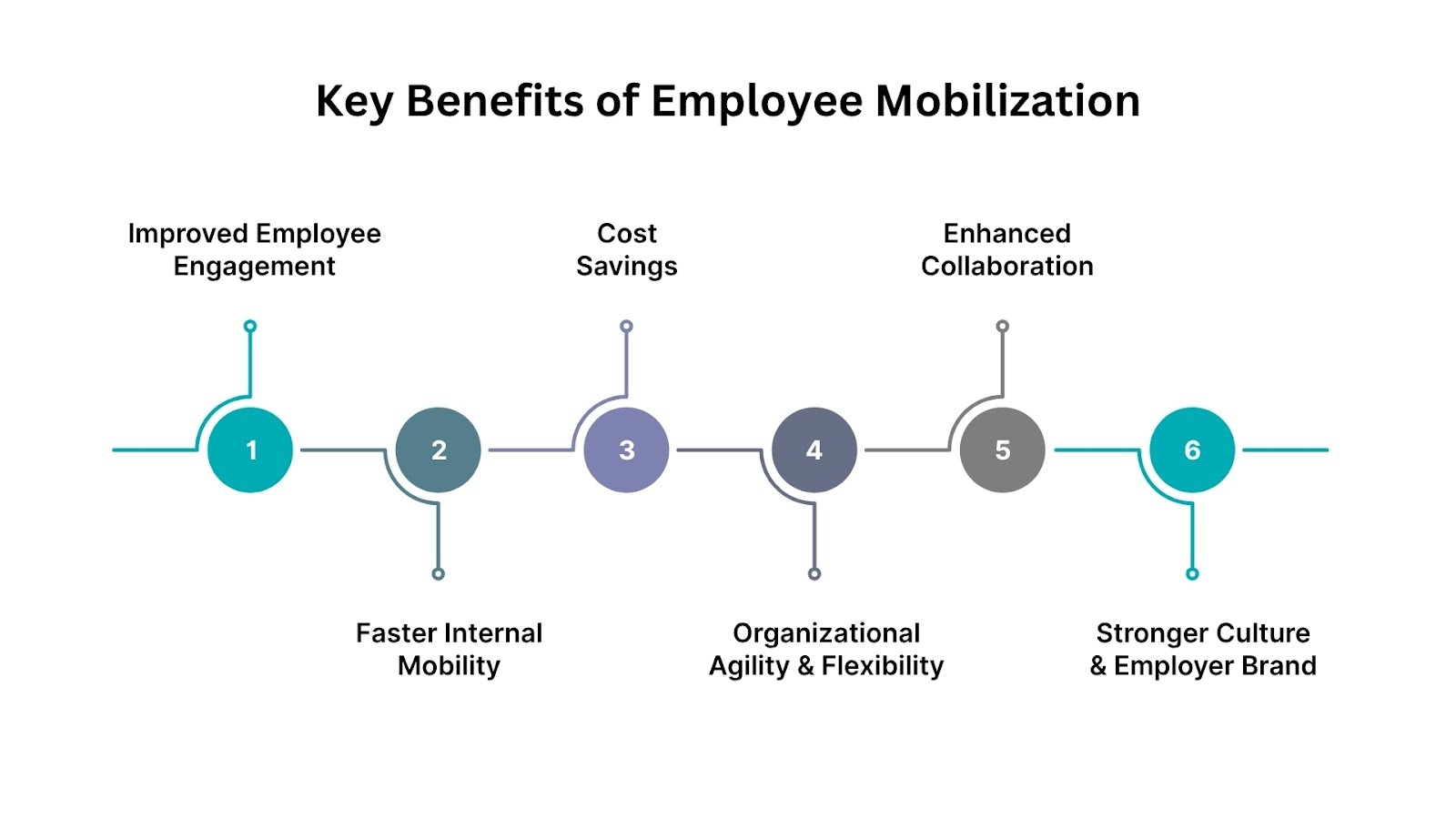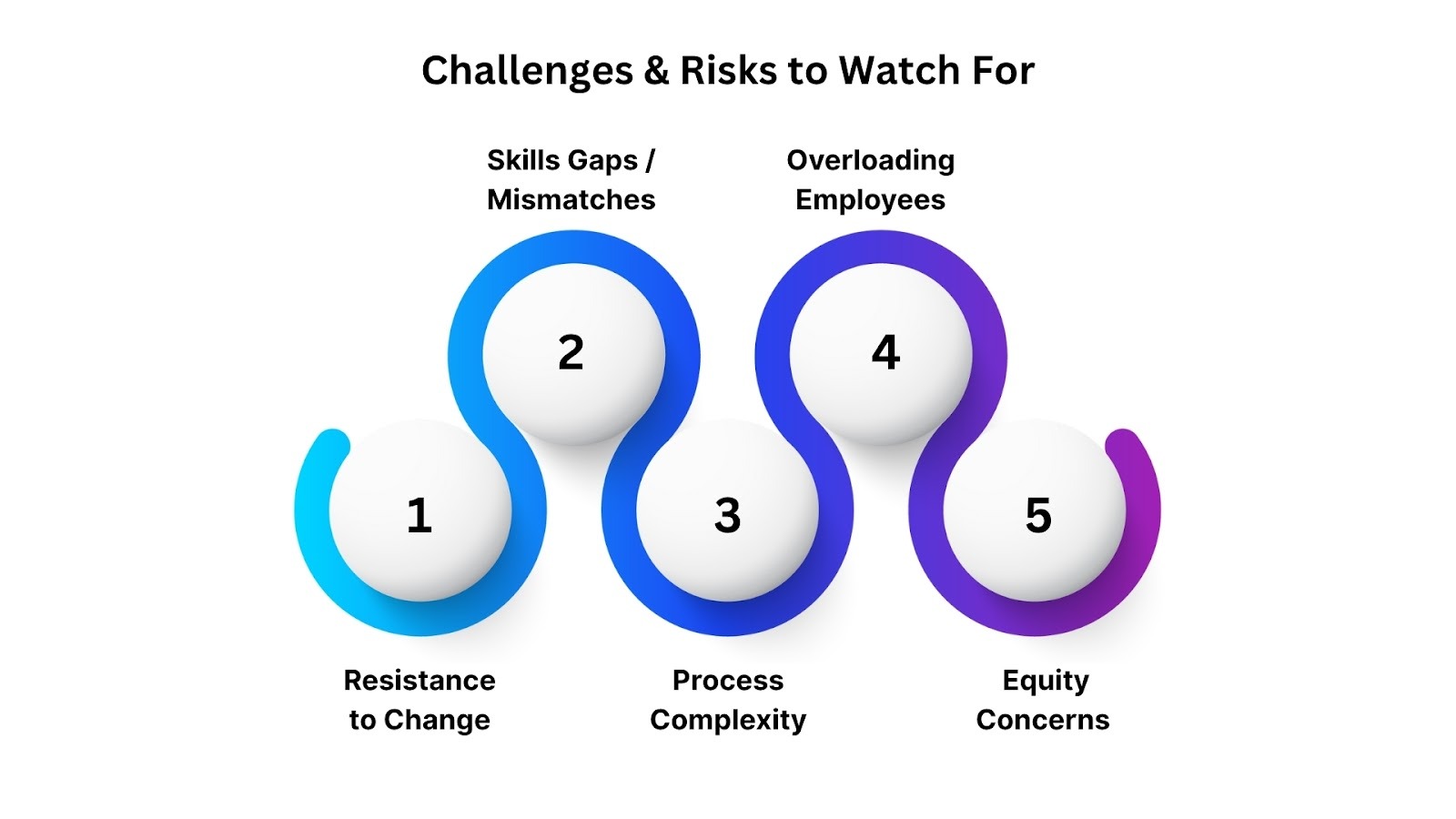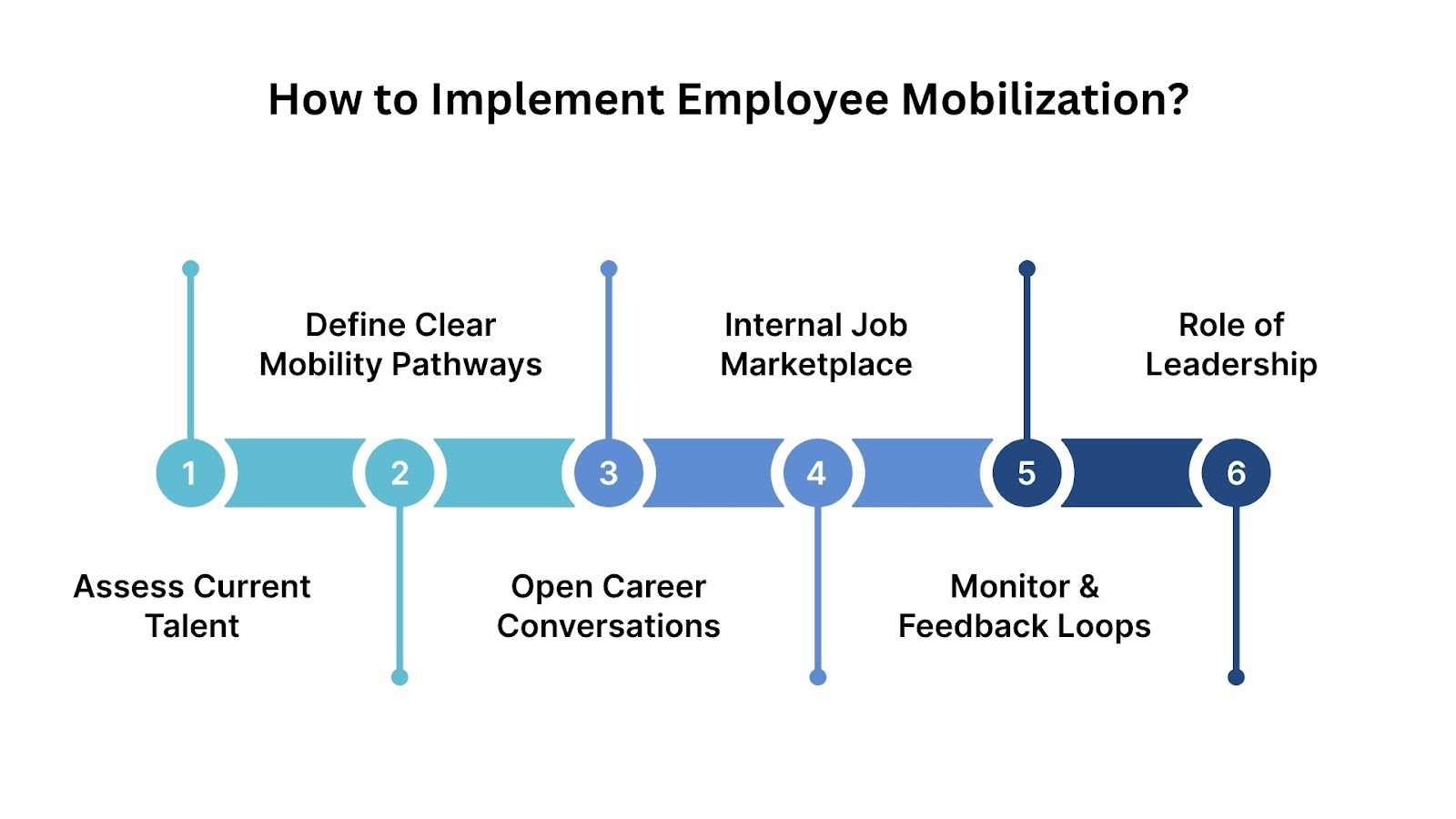
Mobilizing employees isn’t just about shifting roles or relocating staff; it’s about strategically aligning your talent with your business goals. When done right, employee mobilization becomes a powerful lever to enhance productivity, agility, and loyalty.
By employee mobilization definition, we mean the structured process of moving, adapting, and redeploying your workforce across functions, geographies, or projects in alignment with changing business priorities.
In Saudi Arabia, the concept of mobility is gaining traction. As firms look beyond static workforce models, they invest in internal talent strategies to reduce dependency on external hires and improve retention. This movement aligns directly with the goals of Vision 2030, which emphasizes workforce localization, digital transformation, and the development of homegrown talent to drive economic diversification.
For example, organizations are increasingly adopting internal job marketplaces and AI-driven role matching to better leverage their existing staff and adapt rapidly to market shifts.
Why does this matter for your business? Because in competitive sectors, mid-sized enterprises cannot afford inefficiencies.
In this article, you’ll learn how employee mobilization drives retention, agility, and compliance in Saudi businesses, with practical pillars, proven benefits, common pitfalls to avoid, step-by-step strategies, and local success stories powered by HAL ERP.
Employee mobilization refers to the strategic process of redeploying, adapting, and empowering employees to meet the organization's evolving needs and requirements. It involves aligning workforce skills with business objectives, ensuring the right people are in the right roles at the right time.
Unlike ad-hoc transfers, mobilization is a structured approach supported by policies, training, and technology.
It’s important not to confuse mobilization with related HR concepts:
Employee mobilization, however, is broader; it extends beyond engagement and mobility to actively reallocate resources, upskill staff, and break down silos, ensuring your workforce adapts quickly to business shifts.
Employee mobilization can take multiple forms depending on organizational needs:
Each type requires careful planning, communication, and support to ensure employee satisfaction and organizational success.
In Saudi Arabia’s evolving business landscape, employee mobilization plays a vital role:
HAL’s Jash Holding case shows modernization across subsidiaries and thousands of employees, using ERP to standardize processes and support cross-project staff deployment with clear scheduling and reporting.
These examples demonstrate that mobilization is a strategic capability that enables Saudi businesses to remain resilient, compliant, and competitive.
Suggested Read: Best ERP Inventory Management Software 2025
Next, let’s explore the key pillars that make it effective and how to activate them.
Employee mobilization thrives when it is built on strong organizational foundations. These pillars ensure employees feel confident, supported, and motivated to adapt to changing roles or responsibilities.

Without them, mobilization risks being seen as disruptive rather than empowering.
Mobilization begins with trust.
Employees need confidence that decisions about their roles are made fairly and in the company’s best interest. Transparent communication about why mobilization is happening and how it benefits both the business and the individual is essential.
For example, in Saudi Arabia’s manufacturing sector, companies that clearly explain role changes during digital transformation initiatives experience smoother adoption of ERP tools.
Shifting roles without proper resources creates frustration.
Effective mobilization requires training programs, AI-powered tools, and support teams to facilitate a smooth employee transition.
For instance, HAL ERP offers automated workflows and real-time reporting, enabling staff to handle new tasks efficiently without requiring excessive manual effort.
Perceived fairness is a powerful driver of employee acceptance.
If mobilization feels biased or favors certain groups, it erodes trust. Clear policies, measurable criteria, and equal access to opportunities are essential for maintaining justice throughout the process.
True mobilization empowers employees to make decisions in their new roles.
Instead of simply moving staff, organizations must equip them with autonomy and authority to act effectively.
With HAL ERP’s customizable dashboards, employees can monitor performance data and act on insights instantly, reducing bottlenecks.
Mobilization is most effective when employees see a direct link between their new roles and the company’s broader mission.
In Saudi Arabia, where businesses are aligning with Vision 2030 goals, mobilization strategies that connect personal growth with national development objectives inspire stronger employee commitment.
How can companies implement these pillars? Successful strategies include:
When these levers are consistently applied, mobilization becomes not just a policy but a culture that drives growth and resilience.
With these foundational pillars in place, businesses can unlock the real value of mobilization.
When executed strategically, employee mobilization delivers measurable value across the organization. From higher retention to cost efficiency, it’s a driver of long-term business resilience.
For instance, according to LinkedIn data, employees who make internal moves are 40% more likely to stay with their company for at least three years, underscoring how mobility fosters loyalty and stability.

According to SHRM, employees who are promoted within three years of being hired have a 70% chance of staying with the company, underscoring the importance of internal mobility in supporting retention.
In Saudi Arabia, where skilled professionals are in high demand, offering career mobility helps reduce turnover while increasing employee satisfaction.
Mobilization accelerates career pathways by providing cross-functional experiences and upskilling opportunities.
For instance, when manufacturing employees are redeployed into production planning roles with the support of HAL ERP’s AI-driven analytics, they not only acquire new skills but also contribute to operational efficiency more quickly
Suggested Read: Evolution of Manufacturing Operations: How ERP Revolutionized the Industry
Recruitment and onboarding are costly, especially in competitive markets. By mobilizing existing employees into new roles, businesses save on hiring expenses while reducing the time needed for integration.
HAL ERP further reduces costs by automating tasks that would otherwise require additional staff.
Market conditions shift quickly, particularly in the contracting and trading sectors in Saudi Arabia. Mobilization enables businesses to reallocate staff to priority projects without delay.
Mobilization often requires cross-departmental movement, which breaks down silos and fosters collaboration.
A retail company, for example, can reassign store staff to e-commerce operations during peak seasons, ensuring seamless customer service across all channels.
Al Homaidhi Group, with 80+ branches in KSA, adopted HAL ERP to unify inventory, sales, and branch data. This integration enabled smoother staff shifts between store, back office, and digital roles, making mobilization in retail more effective.
Employees who see opportunities for growth within their company are more likely to be loyal and motivated.
This creates a strong internal culture and boosts the employer brand, making it easier to attract top talent. In Saudi Arabia’s competitive labor market, showcasing internal growth pathways helps businesses stand out.
While these benefits are substantial, businesses must also be mindful of potential challenges.

These challenges can slow adoption if left unchecked.
Recognizing them early enables leaders to design strategies that ensure mobilization remains fair, transparent, and sustainable.

Change often sparks anxiety.
Employees may resist new roles or perceive mobilization as favoritism if the process is not transparent and equitable. Internal politics can also derail mobilization initiatives.
Clear communication, visible leadership support, and fair, data-driven processes are crucial for reducing resistance and fostering trust.
Not every employee is ready to step into a new role immediately.
Without proper upskilling, businesses risk productivity drops or project delays. For example, in Saudi Arabia’s services sector, redeploying staff without adequate training on compliance and VAT processes can lead to costly errors.
HAL ERP mitigates this by providing role-based access and reporting that supports on-the-job learning.
Mobilization involves multiple stakeholders, including HR, managers, and employees. If the process is complex or lacks visibility, it creates confusion and mistrust.
Automating workflows simplifies processes and ensures clarity at every stage of the process.
HAL addresses this through its HRMS solution, designed to build a collaborative, future-ready workforce by integrating HR functions, streamlining communication, and making mobility decisions more transparent.
When mobilization is poorly planned, employees may be assigned additional tasks without removing old ones. This leads to burnout, lower engagement, and attrition.
Effective workforce planning with ERP tools ensures balanced workloads and prevents overextension.
If employees believe opportunities are distributed unfairly, mobilization efforts backfire. Clear criteria, unbiased performance data, and structured policies help create a culture of fairness.
HAL ERP supports equity by offering objective, data-driven reporting on employee performance and allocation.
Addressing these challenges is critical, but having a roadmap for success is equally important.
Employee mobilization succeeds only when organizations approach it as a structured, strategic initiative. Instead of one-off transfers, it should be treated as a continuous cycle of assessment, development, and redeployment.

Here’s a proven framework to follow:
Begin with a skills audit across departments. Identify core competencies, emerging skills, and critical gaps.
For instance, a mid-sized trading company in Jeddah might discover underutilized digital marketing expertise within its sales team.
Pro tip: Combine ERP data with employee self-assessments to gain a more holistic view of capabilities.
Employees need to know how mobilization works within your business. Develop formal pathways, vertical (promotion), horizontal (cross-department), and geographic (branch-to-branch).
Policies should address:
In Saudi Arabia, this also means defining responsibilities tied to ZATCA compliance and VAT reporting when mobilizing finance or accounting staff.
With HAL ERP, workflows can be automated to ensure employees in new roles remain compliant with Saudi regulations.
Suggested Read: Understanding VAT in Saudi Arabia: From Zakat to VAT Calculators
Mobilization without communication risks failure. HR and leadership should conduct regular career conversations to offer visibility into potential growth opportunities. Pair this with mentoring or coaching programs to reduce uncertainty.
A GCC workforce survey found that four “employee journeys” have a disproportionately large impact on whether employees join or stay. Crucially, feedback & coaching, as well as training & skill building, are among these; when executed poorly, satisfaction drops notably with tenure.
Employees thrive when they can actively participate in their mobility journey. Establishing an internal job marketplace lets staff view available roles, express interest, and apply.
Mobilization is not a one-time project; it requires ongoing tracking and optimization. Key performance indicators (KPIs) include:
HAL ERP enables managers to track these metrics in real-time, ensuring adjustments are made promptly.
For example, if a mobilized employee’s workload exceeds capacity, the ERP can reassign tasks to prevent burnout.
Leadership buy-in determines success.
Executives and managers must champion mobility as a growth opportunity, not a disruption. Meanwhile, HR plays the role of architect, designing fair policies, facilitating training, and embedding ERP-supported workflows to ensure seamless execution.
By combining structured policies with supportive technology, mobilization becomes a practical strategy rather than a vague concept.
So, when does employee mobilization make the most sense? Let’s find out.
Employee mobilization is not a one-size-fits-all strategy.
It works best in specific contexts where businesses are prepared to support employees with the right structure, policies, and technology in place.
Mobilization delivers the greatest impact in mid-sized to large enterprises with established teams and growing operational complexity. In Saudi Arabia, the following industries are especially well-suited:
Smaller firms may benefit in limited ways, but the cost savings and efficiency gains are more pronounced in larger organizations, where resources and compliance requirements are more complex and extensive.
Certain business scenarios make mobilization not only useful but essential:
While mobilization is powerful, it is not always sufficient. Some situations require external hiring, such as:
In these cases, mobilization can still complement hiring by ensuring that existing employees cover transitional gaps and provide support during the onboarding process.
By understanding when mobilization works best, businesses can make informed decisions about workforce planning.
Suggested Read: Impact of AI on ERP Systems: Transforming Business Operations
Employee mobilization succeeds only when businesses have the right systems in place to simplify transitions, reduce risk, and empower employees.
HAL ERP is specifically designed to meet this need, offering AI-driven automation and industry-specific solutions that enable Saudi enterprises to mobilize their workforce seamlessly.
HAL ERP is tailored to the unique challenges of Saudi businesses across industries:

Unlike general ERP platforms, HAL ERP is built with Saudi businesses in mind. It offers:
While competitors like Tally, Odoo, Microsoft Dynamics, SAP Business One, and NetSuite offer broad ERP solutions, HAL ERP stands out by combining industry-specific features, AI automation, and Saudi-focused compliance tools.
This makes it not just a software choice, but a strategic partner in workforce mobilization and business growth.
With HAL ERP, mobilization is no longer a manual, uncertain process; it becomes a structured, technology-driven strategy that strengthens retention, agility, and compliance.

Employee mobilization is no longer optional, it’s a strategic necessity for Saudi enterprises striving to achieve Vision 2030 goals. By enabling employees to move seamlessly across roles and departments, organizations can reduce hiring costs, improve retention, and build a compliant, future-ready workforce.
With HAL ERP, mobilization becomes simple, automated, and data-driven. Our AI-powered workflows, industry-specific modules, and ZATCA-compliant localization empower Saudi businesses to redeploy staff efficiently , without disruption or compliance risks.
Is your workforce strategy ready for Vision 2030 compliance?
Join leading Saudi enterprises already reducing hiring costs by up to 40% and accelerating transformation with HAL ERP.
Book your free HAL ERP demo today and experience how our KSA-focused solution drives workforce agility, compliance, and sustainable growth.
1. What is employee mobilization vs internal mobility?
Employee mobilization involves the structured redeployment of employees across roles, projects, or locations, accompanied by training and organizational support. Internal mobility refers more narrowly to promotions or transfers within an organization's existing structure.
2. How long does it take to see results from a mobilization program?
Depending on size and complexity, changes in retention, role fill rates, or collaboration often become visible within 3–6 months, especially when supported by real-time tracking.
3. What metrics should I monitor to evaluate mobilization success?
Key metrics include internal fill rate, employee retention after transition, time to role fill, training completion rates, and employee satisfaction scores.
4. How can businesses in Saudi Arabia ensure mobilization remains compliant?
By using ERP or HR systems that integrate VAT/ZATCA compliance, labor law rules, and payroll/attendance modules, redeployments don’t trigger legal or taxation issues. HAL’s localized modules help support this.
5. When should a company focus on internal mobilization rather than hiring externally?
Mobilization is ideal during restructuring, scaling, or digital transformation phases. It’s less suitable for hiring highly specialized or niche roles that aren't currently present in the organization.